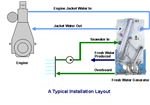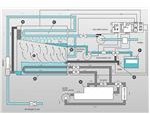How is fresh water generated on a ship? Is it possible to generate drinkable fresh water from sea water?
Yes and
for this purpose, a fresh water generator is used on a ship.This article will
show the arrangement and working of a normal fresh water generator on a ship.
Introduction
Fresh water is of dire need on a ship. It is
used for various purposes such as drinking, for preparing food, in laundry
services and in many other day to day activities. In the past, people used to
carry tons and tons of fresh water in barrels or in specially made tanks. This
was because there were no other sources of fresh water once the ship was in
sea, except rain, which was quite unpredictable.
Today in spite of means
on board to generate fresh water, ships carry tons and tons of fresh
water in segregated fresh water tanks. But there are many other processes in
which fresh water is used and as generally the fresh water tanks provided are not
sufficient, the need arises to generate fresh water onboard. Fresh water is
always in dearth also because it is very difficult to keep a check on the water
usage by the crew members and also the usage cannot be avoidable as water is
continuously required onboard ship.
Fresh water is generated on ship by a fresh
water generator, also known as evaporator. The process by which fresh water is
generated is known as distillation process. Sea water is converted into fresh
water by evaporating and condensing the sea water. Evaporation of the sea water
is either done by boiling or by flash process. This process enables the
reduction of 32,000 parts per million in sea water to 1 to 2 parts in fresh
water. Fresh water generators can be tube type or plate type.
Single stage fresh water generator
A fresh water generator consists of mainly two parts. A condenser and an evaporator. The boiling process is done either by a heating coil or by using the high temperature main engine jacket water. In some FWGs, heating is also done by superheated steam. Generally water is boiled at 100 degree Celsius, but in freshwater generator it is done at around 60-70 degree Celsius. For this purpose, educators or air ejectors are use. Eductors reduces the chamber’s pressure to such a point that water starts boiling at a temperature of 60-70 degrees Celsius. A flow meter is used to regulate the flow of sea water into the generator. The freshwater generated in the condenser is later collected by a distillate pump. A salinometer is used to check the salinity in the fresh water generated.
Working of the FWG
The hot jacket water from the diesel engine is passed through the evaporator’s heated nest. The sea water enters the evaporator through the flow meter and due to the low pressure of the chamber; it boils and gets converted to steam. Generally the feed of the seawater is kept half the stated quantity to facilitate adequate boiling of sea water. The steam then passes through a steam separator, in which the water particles in the steam are separated and collected.
The steam then enters the condenser, where it cools down to form fresh water. It is then removed from the condenser with the help of a distillate pump. The remainder sea water particles or the brine which gets collected at the bottom is drawn out with the help of an ejector pump.
Flash process- Increasing the efficiency
A liquid which is already having sensible amount of heat when introduced in a pressurized chamber, immediately gets converted to steam, i.e. in a flash, without the boiling process. Thus the phenomena can be used to acquire higher level of efficiency by controlling the exact pressure and temperature of the water, which will lead to higher energy efficiency.
This can be done by using a double stage fresh water generator.





No comments:
Post a Comment